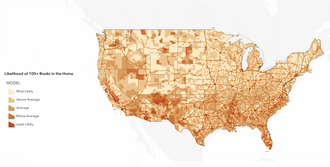Book desert
A book desert is a geographic area (country, state, county, city, neighborhood, home) where printed books and other reading material are relatively hard to obtain, particularly without access to an automobile or other form of transportation.[1] Some researchers have defined book deserts by linking them to poverty and low income, while others use a combination of factors that include census data, income, ethnicity, geography, language, and the number of books in a home.[2]
Initiatives that increase the availability of books by such measures as bookmobiles and librarians on bicycles have been offered as possible solutions to book deserts, as have Little Free Libraries and offering children's literature available online, free of charge.[3]
Background and research
In the past, researchers have studied how the absence or scarcity of books impact how a child's early
In July 2016, professors
Contributing factors
Multiple factors are credited as contributing to the formation of book deserts, the most frequently highlighted of which tends to be poverty and low income. Other factors tend to include language and geography, as some areas lack access to bookstores or public or community school libraries that would provide books.[8] Book store closures due to bankruptcy or other financial difficulties are also occasionally cited as a contributing factor, when the closure leaves the area without a bookseller.[9]
Depictions

In 2023, Unite for Literacy worked with the Colorado State University Geospatial Centroid to refine the book desert map. The Centroid team compiled and analyzed data from NAEP, the Census Bureau, and Diversity Data Kids, along with survey responses from more than 10,000 participants in the Unite for Literacy’s Growing Readers program.[11] The new map more consistently and accurately identifies how likely households within census tracts are to have an abundance of books when compared to other tracts.
References
- ^ S2CID 147841185.
- ^ a b Silvy, Tyler (July 30, 2014). "Searching for oases in Weld's so-called book desert". Greeley Tribune. Archived from the original on September 14, 2016. Retrieved August 6, 2016.
- ^ Gilbert, Jeff (June 26, 2016). "Literacy initiative aims to eliminate 'book deserts'". Dayton Daily News.
- .
- ^ Poulton, Lizzie (July 7, 2010). "A book of their own: how owning books affects children's literacy". Literacy Trust. Archived from the original on September 18, 2016. Retrieved 2016-08-06.
- ^ LaRue, James (March 4, 2014). "The Price Is Right at Unite for Literacy". American Libraries Magazine. Retrieved 2016-08-06.
- ^ a b c Wong, Alia (July 14, 2016). "The Children Who Grow Up in 'Book Deserts'". The Atlantic. Retrieved 2016-08-06.
- ^ Santelli, James (July 30, 2016). "Warren group works to fight 'book desert' phenomenon". WKBN. Retrieved 2016-08-06.
- ^ Gelles, David (April 14, 2012). "Store closures create US 'book deserts'". The Financial Times. Retrieved August 6, 2016 – via Academic OneFile.
- ^ "Unite for Literacy library".
- ^ "Growing Readers". Unite Books. Retrieved 23 March 2024.
Further reading
- Evans, M.; Kelley, J.; Sikora, J. & Treiman, D. J. (2010). "Family scholarly culture and educational success: Books and schooling in 27 nations", Research in Social Stratification and Mobility 28(2): 171–197. .
- Evans, M.D.R., Jonathan Kelley & Joanna Sikora (2014). "Scholarly Culture and Academic Performance in 42 Nations." Social Forces 92(4): 1573–1605. .
- Gollner, K., Webster, T. & Nathan, L. "The Neighborhood Book Exchange: Community Catalyst or Media Hype?" (PDF). doi:10.9776/13323. Retrieved 2013-05-08.
- Gwinn, Mary Ann (August 2, 2015). "'Like a human bird feeder': Readers share Little Free Library tales". The Seattle Times. Retrieved 6 September 2015
- Moland, Naomi and Susan B. Neuman. "Book deserts: Unequal Access to Print Resources in America's Cities." To be submitted to Urban Education.
- Neuman, S. B., & Celano, D.. (2001). "Access to Print in Low-Income and Middle-Income Communities: An Ecological Study of Four Neighborhoods". Reading Research Quarterly, 36(1): 8–26. .
